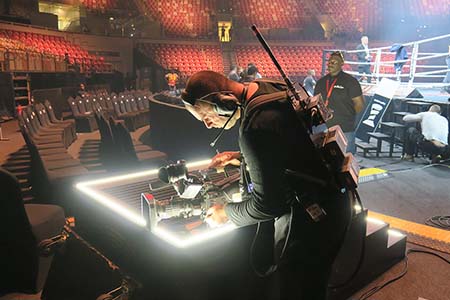The system is intended for use with a combination of unmanned remote-control broadcast HD pan/tilt/zoom cameras, goal cameras and traditional-style manned ENG tripod-mountable cameras, among others.
CJP Broadcast has announced a new addition to its range of products and services with the introduction of a fully integrated portable live sports production system. Comprising the Streamstar production unit, InPlayer video-on-demand paywall and JW Player streaming service, it provides the core resources needed to create complete programmes for live streaming or VOD distribution.
Available in several versions supporting up to eight camera inputs, the system can ISO-record multiple source feeds simultaneously, plus the live output stream, to a 1 terabyte internal SSD for live mixing or offline postproduction.
It is intended for use with a combination of unmanned remote-control broadcast HD pan/tilt/zoom cameras, goal cameras and traditional-style manned ENG tripod-mountable cameras, wireless drone cameras or auxiliary sources such as Skype-TX-connected guests.
Integrated into the system are a selection of production capabilities include four-layer graphics, transitions, real-time replay, slow-motion replay, on-the-fly highlights creation, advert insertion, clip insertion and audio mixing. Operation is via a touch screen and keyboard with the option of an external joystick for pan/tilt/zoom camera control.
Full multiscreen monitoring facilities are included with the option of a second screen for commentator positions. An H.264 live stream can be fed back directly to a TV station or third-party OB control suite via a 10 megabits per second link or via 4G mobile, with the ability to simulcast to multiple platforms and in-stadium screens. Up to 96 terabytes of RAID5 attached storage can be connected.
Commenting on the new system, CJP Broadcast Managing Director Chris Phillips said: ”This all-in-one solution opens up the world of mobile TV production and live streaming to organisations such as Tier 2 sports rights owners, leagues and clubs that hitherto would have been challenged by the economics, technical complexity and crewing overheads of traditional broadcasting.
“It can be operated easily by a single one person for a small production or a three-person crew comprising one production controller, a camera supervisor and a commentator. Any organisation, regardless of size, can now afford to establish and operate its own TV-branded web channel which also forms a perfectly practical source of revenue through sponsorship opportunities, advertising sales, merchandise promotion and upcoming event publicity.”












































































